… and another bonus BRIEF
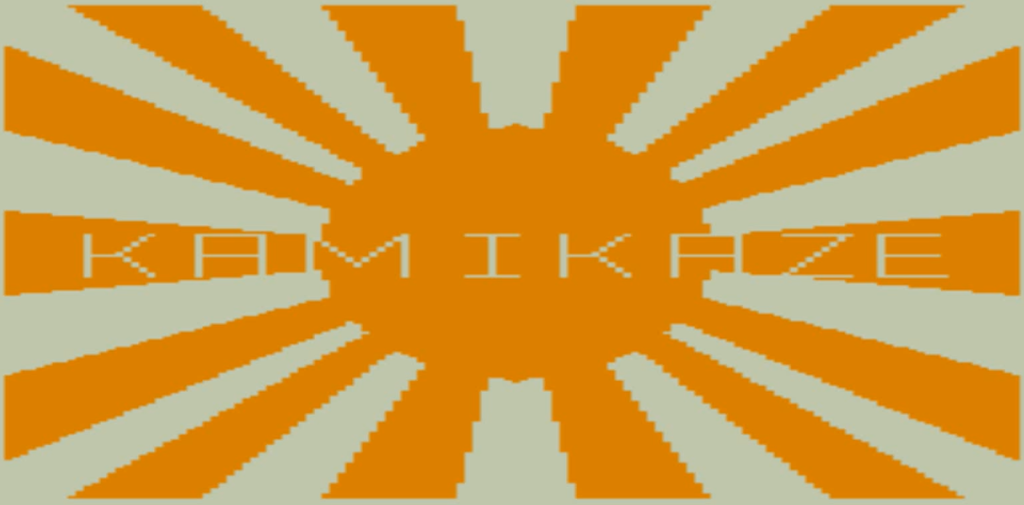
What’s the standard operating procedure in case of a kamikaze attack ?
Don’t worry about this. If it happens, the Admiral of the Fleet will personally man the anti-air guns and shoot the kamikaze down, but only if someone gives him a joystick.

Released in March 1983, Kamikaze is the second game by Ark Royal games, the Color Computer wargame specialists who started their game portfolio half a year earlier with the unassuming Across the Rubicon (1982/1983).
Kamikaze starts on the 1st of January 1945 and puts you in charge of a small fleet of 12 ships, plus 3 picket ships (“Q”, “R” and “S”) led by the fictitious aircraft carriers USS Seminole and USS Dolphin.
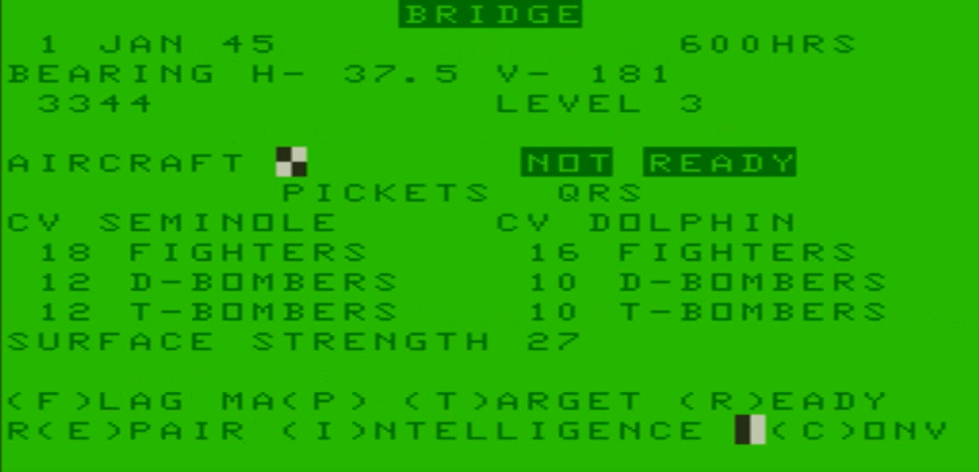
The line-up on the Seminole indicates it is supposed to be a light Saipan-class aircraft carrier and the Dolphin an even lighter Independance-class carrier so clearly I am not leading Team A. At least I have some significant escort – it’s not like the US Navy has any better use for its battleships at this point in the war.
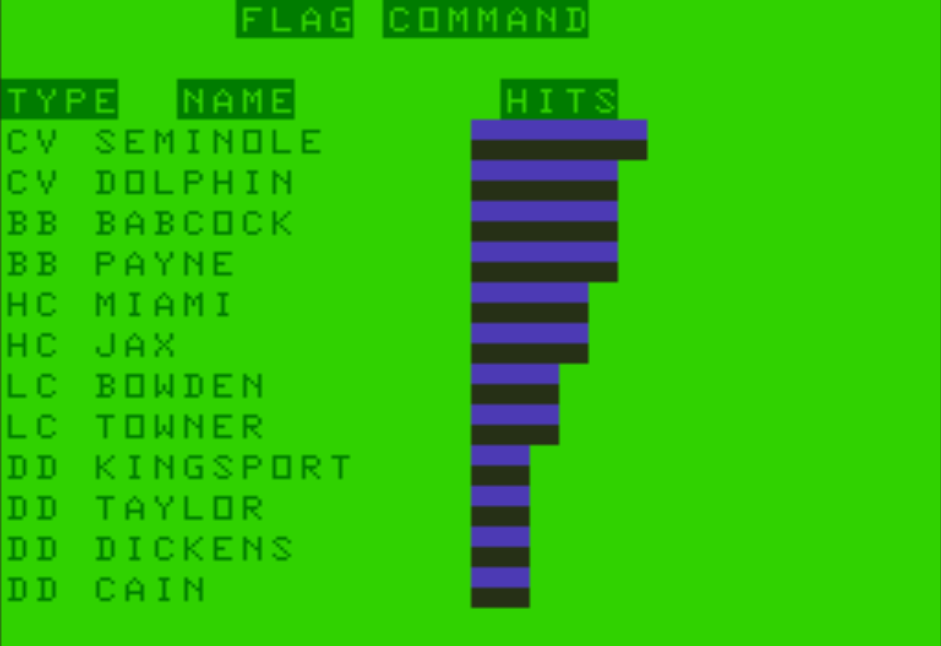
The objective is to seek and destroy a Japanese fleet of 16 ships within 8 days, in game terms 32 turns (4 turns a day, no night turn). The enemy fleet includes, according to the manual, the battleship Yamato itself so maybe I am only leading Team B, but I will still have a story to tell the folks back home if I survive!
After allocating some planes to close air patrol (CAP), it is time to look for the Japanese.
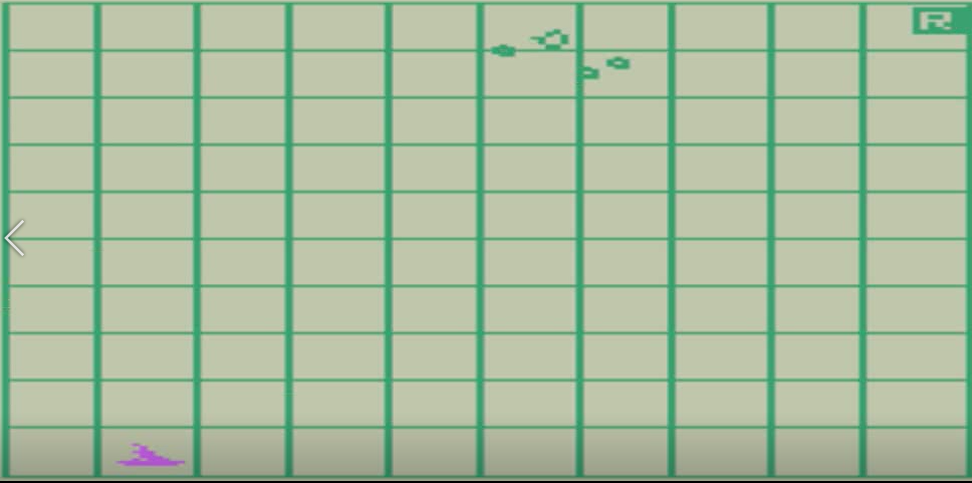
On the map, I am allowed to do 3 search actions :
- Radar, which checks all tiles within a two tiles radius of my position, with some chance to miss stuff,
- My search planes, which check any 4 tiles on the map, with 100% chance of success – they are invulnerable and “free” as using them does not take away planes from my attack or my CAP,
- My 3 picket ships, each one can check with 100% success rate one tile at a range of 3 ; but if they find the enemy fleet they are lost.
The Japanese fleet always starts at the top row, so 10 possible locations. I have 40% of chance of finding them in the first turn, and I get lucky :
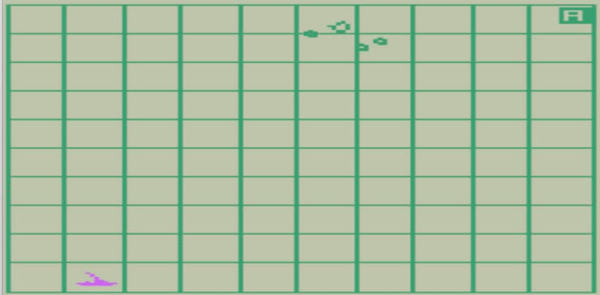
I find the enemy fleet, in addition to some patrolling planes (in orange) not too far from me. I could intercept the latter with my own planes, but it’s less costly to just avoid them.
After the search phase, I get to move my fleet by one tile. The manual is unclear about this, but I think enemy patrol also moves by one tile by turn so I move East for now.
Kamikaze has a huge simplification in terms of plane management : either all your planes are active (in which case you allocate them between CAP and “readiness” to strike), or none of them are. If your planes are active one turn, they cannot be active the following turn (except if the following turn is the first turn of the day), which obviously makes you very vulnerable to enemy air attacks.
In any case, I spend the first day avoiding enemy patrols, and moving toward the enemy fleet. The enemy fleet can only move one tile per turn in any direction (including diagonals), and I also have occasional intelligence reports giving me its general location, so I can move toward it relatively easily.

I lose my target briefly during the night, but on the 2nd of January at 10:00, the enemy fleet is both detected and in range !

I immediately send my bombers. I had allocated the maximum number of fighters (16) to CAP, so I send my bombers without much of an escort, but it turns out OK because the enemy has no air support at all !
This is the attack phase : I must first allocate my torpedo bombers to enemy ships :

The allocation is weird : you never identify the ships you attack, and the only rule you need to take into account is that a plane can attack, and be attacked, only by ships adjacent to where you place it. This means attacking the ships in the middle is risky, but the ones on the sides are easy picking. You also need to allocate every torpedo-bomber individually (22 of them in my case), so each icon actually represents 4 or 5 planes I positioned on top of each other.
I lose a bunch of bombers (not sure how many as they are stacked), but I sink 3 ships :

After that, it is time to allocate my dive bomber. Unlike the torpedo bombers, they can be placed directly on top of enemy ships, so they can safely attack the middle of the formation. Not that I care, since I don’t know which ships I am attacking. In this second wave, I destroy 6 ships, so the enemy fleet is down to 7 ships.
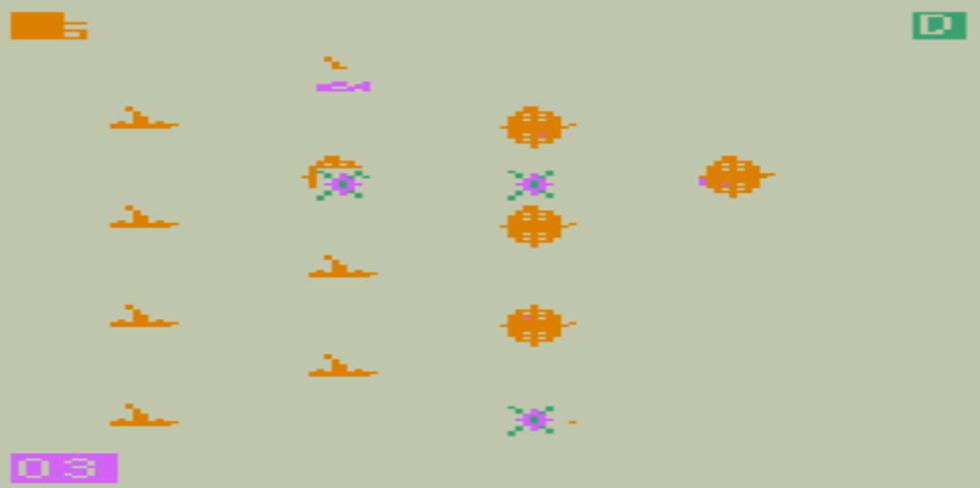
There is no counter-attack, as in Kamikaze the enemy fleet does not send its own planes – the only air attacks come from the roaming kamikaze wings.
Unable to ready planes the following turn anyway, I use the downtime to replace my lost bombers by converting my fighters into torpedo-bombers. You read that properly – apparently I can perform some hocus pocus on a Hellcat and voilà, now it is an Avenger.
Sadly, replacing planes means not having access to the map for one turn, and I lose track of the enemy. Worse, I get stumbled upon by two enemy kamikaze patrols !

This starts the “defence” section of the game. At the beginning of a session, the game asks you whether you want to defend personally using your joystick, in which case you apparently aim yourself at the incoming planes. Thankfully, I did not manage to set up a joystick in the emulator. so the defence was automatic. “Thankfully”, because that part of the game is agonizingly slow – a full 40 seconds by enemy wave (there were 2 of them)… when my emulator was accelerated 5 times compared to the speed of the real computer.
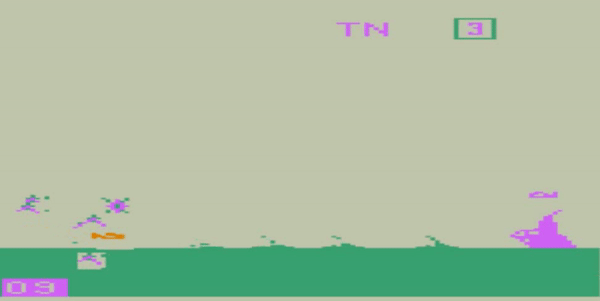
I receive some damage, but no ship is lost. Possibly, the CAP mission I had in the air helped, but really I don’t know.
I could spend some time repairing, but while I repair I cannot search for the enemy. Even if my carriers are intact the crew of the Seminole is apparently watching the crew of the Towner or whatever working on their ship, probably commenting on how shoddy their repairs are. I don’t have time to spare, so I carry on my hunt.
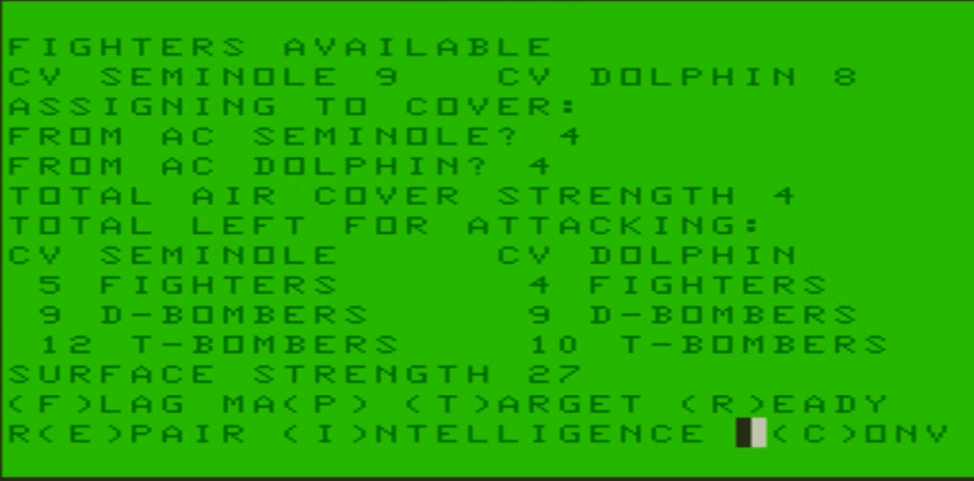
And indeed, on the 3rd of January, I find the enemy fleet again, thanks to a picket ship that sacrifices itself in its duty :

This time, it has an “escort” (a kamikaze patrol that happens to be flying at the same location). Due to this escort, I first send my CAP planes:
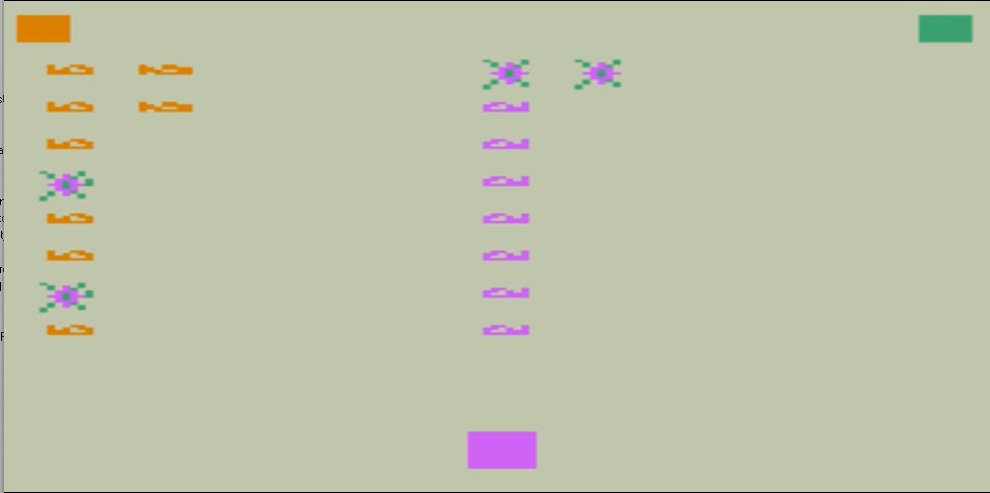
I lose all my CAP planes, but there are only a handful of kamikaze-turned-fighters left, and I can now send all my readied planes, including more fighters :

Once the enemy planes are destroyed, it is the final attack on the enemy :

And with that, I sink the enemy fleet and win the game :

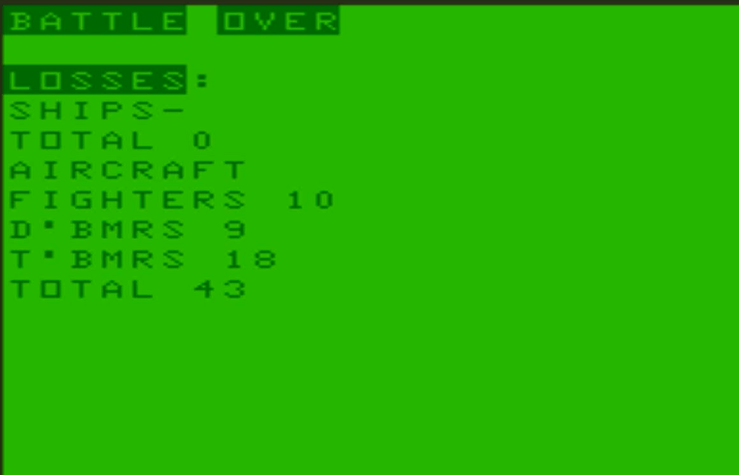
Review and rating
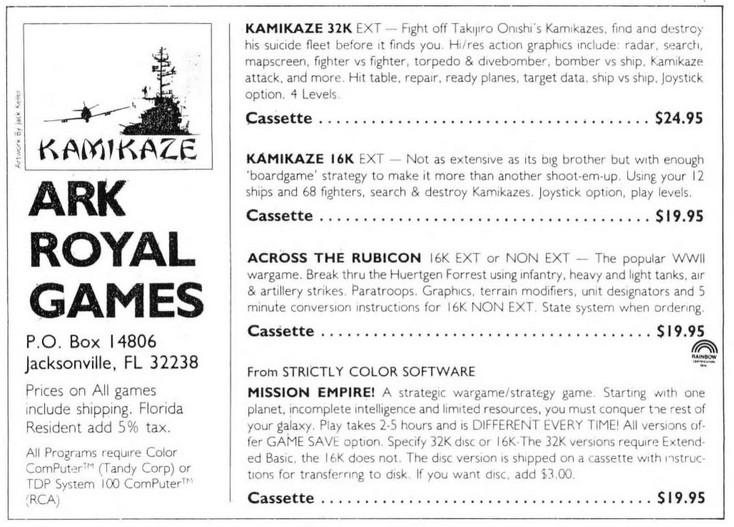
Kamikaze [32K] by Ark Royal Games, USA
First release : March 1983 on Color Computer,
Tested on : MAME
Total time tested : 3 hours
Average duration of a campaign: 30 minutes
Complexity: Easy (1/5)
Would recommend to a modern player : No
Would recommend to a designer : No
Final Rating: Totally obsolete
A. Immersion
If I was mean, I would say the game was designed by someone who read a book about the Pacific War a few years prior, and tried to make a game from pure recollection : fighters can be converted to torpedo-bombers, Japanese kamikazes randomly flying like modern loitering drones and then becoming fighters if they meet your planes, … More probably, the designer went for a strict “gameplay first” approach, not giving any concession to realism. The immersion is only saved by the fact that the Pacific War’s nature (“search of enemy carriers and strike first with your planes”) is so specific that it allows for many historical mistakes and still feels “Pacific War”.
Rating : Very poor
B. UI, Clarity of rules and outcomes.
The game is irritating to play, with the keymap inconsistently displayed on the screen and lots of missed inputs (maybe emulator-related, but I didn’t encounter this issue with Rubicon). The latter is aggravated by the number of key presses you need to allocate your 40+ torpedo-bombers and dive bombers when you attack.
Very little is explained in the game. The manual does not help much: it is well-written, but incomplete. I have no idea what is the impact of losing ships on air defence, whether there are rules for the movement of enemy air patrols or if I was simply lucky, …
What saves the game from total disaster is that it is simple enough that you can still get into the action quickly.
Rating : Very poor
C. Systems
Kamikaze has a lot of interesting systems that get ruined one way or another. To take a few examples easy to explain :
- You can attack enemy patrols, but except if they are above the enemy fleet this is totally useless as you can more simply and economically avoid them,
- You can allocate planes to different targets, but since you cannot identify the individual ships, why would you care ?
- You can allocate players to combat air patrol, but there is no indication that it helps in any measurable way,
- You have a “radar contact” feature which according to the manual should tell you “type, direction, number and distance” of enemy planes you detected. Except there is only one type of enemy plane, you can already see the enemies on the map and the radar gives you the direction from you, not the direction the enemy planes are heading toward. The feature to be useless.
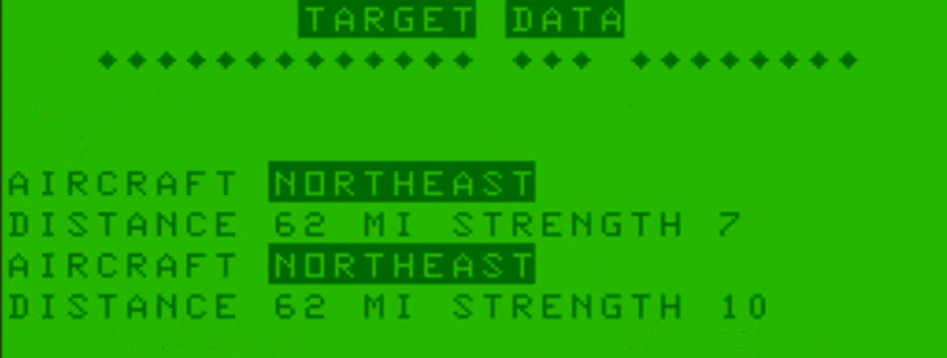
I will be charitable and not mention the action phase either.
Rating : Terrible
D. Scenario design and balancing
There is only one scenario with 4 levels of difficulty. My AAR is my first serious attempt at the game, directly at difficulty 3. I won again at my second attempt also at difficulty 3. Then I played at difficulty 4 and at that level the kamikazes almost always make it through your defence – I never won any game difficulty 4.

There is no AI to speak of.
Rating : Very poor
E. Did I make interesting decisions ?
No. Decisions are either pretty random (trying to find the enemy fleet when you have no hint) or trivial (send planes the minute you see the enemy fleet and it is at range). Avoiding the enemy kamikaze patrols and surviving their attacks is luck, not skill.
F. Final rating
Totally obsolete.
Contemporary Reviews
Advertised for the first time in March 1983 in Rainbow magazine, Kamikaze received its only review in April 1983 in … Rainbow magazine. I expected a 5-star review, showcasing once again the healthy relationship between video games magazines and video games advertisers, but it’s not quite so. Sure, Neil Edward Parks praises the game somewhat (the game is “refreshing“), but the review remains fairly neutral and Edward Parks complains about the lack of graphics (a typical key selling point in that era) in the most decisive parts of the game : your attacks and the surface combats. I don’t think the surface combats are a decisive part of the game (they are easy to avoid, and should be avoided as your fleet is much weaker than the Japanese one) but I agree that the attacks are disappointing even compared to Guadalcanal Campaign, which only uses text.
Kamikaze is a disappointment after Across the Rubicon, but then I actually played the much-improved version Across the Rubicon 32K (“Rubicon II“) and that one was released in late 1983 ; in my short tests of Across the Rubicon 16K I found that earlier version barely playable due to its terrible UI, so presumably Ark Royal Games was still in its learning phase in early 1983. Hopefully, their future games would be on the good side of the learning curve – but we will see that later this year.
Bonus BRIEF
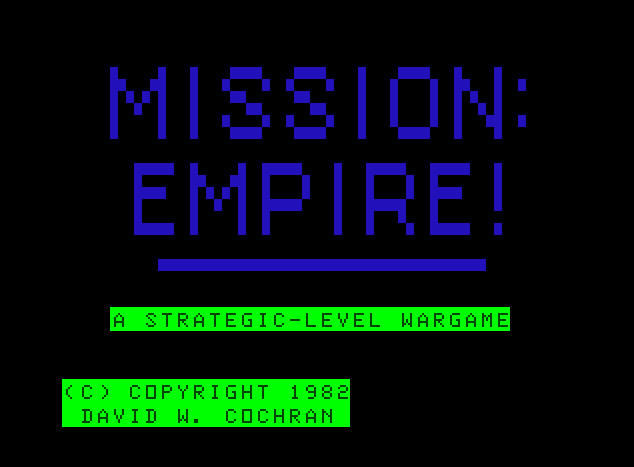
Since I am talking about Ark Royal Games, let’s cover quickly Mission: Empire!, a 1982 game by a company called Strictly Color Software that became advertized and presumably published by Ark Royal Games starting in March 1983.

The game describes itself as a “strategic-level wargame” – perfect for this blog. And well, that’s true ! You are the ruler of a planet and you plan to conquer a galactic empire in less than 1000 years, starting in Year 1 of the new era.

Starting with just one planet, you must conquer some 20+ worlds (whose names all start with a different letter, for quick selection) with the help of 4 kinds of units :
- Naval Squadrons, to control the air space around planets,
- Marine Battalions, the soldiers who will land on planets and conquer them,
- Marine Cadres, which is not really a unit but the maximum number of battalions you can field,
- Scout ships, because worlds are pretty distant from each other so it is good to know in advance whether a given world can be possibly conquered.

….hmmm… wait… the look of the starmap… the objective of the game… the type of units… even the menu…they remind me of something…

Mission : Empire! is indeed a blatant rip-off a carbon-copy hommage to Galactic Empire, down to the balancing data like the unit prices or which percentage of the population you can recruit to join your legions marines. I could only find one somewhat significant difference : Mission : Empire! includes an “advanced” gameplay mode where planets can revolt and, maybe, there is at least one other world-conquering faction (but I did not see them in my short tests),

In any case, that’s pretty much a game I already played, so I am not going to do it again.
Well, at least, this shortened my to-do list !